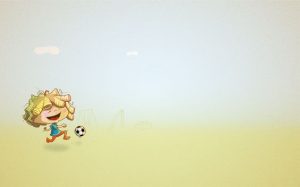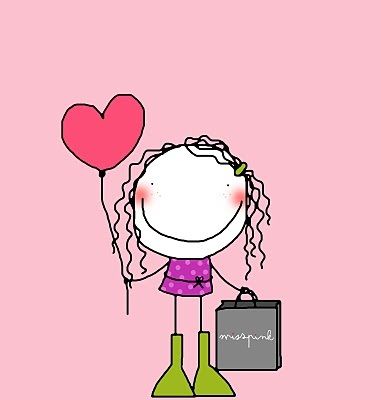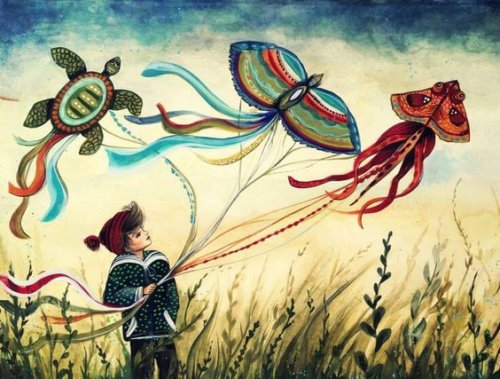An Active Child Is a Happy Child


Reviewed and approved by the psychologist María Alejandra Castro Arbeláez
Like many mothers, you may have idealized motherhood. Yet now you feel dejected because although you dreamed of having a child, you never imagined their behavior would be like this. However, there is nothing to worry about or regret. Every active child is a happy child.
Contrary to what you might think, an unruly, noisy, restless or active child can actually be synonymous with happiness. Have you never been told that you should feel happy about your child’s energy because it implies having a totally healthy child?
“That baby does not stay still,” you hear people repeating again and again. Fortunately, this is absolutely normal. The error consists in the absurd pretension that a child behaves in the same way as an adult.
Through this unruly behavior or activity that bothers adults so much, children get to know the world around them.
An active child is one who learns by exploring
An active or unruly child, in addition to being free and happy, is a child who is in the process of learning. Through these explorations and childhood adventures, the child discovers objects, textures and reactions. Therefore, it is not convenient to restrict these lessons that life itself gives.

It would be a mistake to forget what childhood consists of and the importance of this stage, which is without doubt one of the most creativity stages for each individual. Those who undertake this sacrificial but beautiful mission of parenthood must opt for empathy.
What’s better than to connect with those wonderful years that have marked our lives, leaving a new legacy signed by those mischievous adventures that become the best memories and anecdotes remembered with a smile?
Your baby will cry, laugh and scream. It’s his way of communicating with you and expressing what he feels, as well as expressing some need or annoyance. Not to worry. You are doing well despite not having a manual for motherhood.
In the same way, your little one will jump, run, sing and ask insistent questions. It is part of his game. The playfulness of childhood is more than just fun and entertainment; it’s also educational.

An active child is a fulfilled child
An active child is a happy, fulfilled child. As you well know, little ones want to touch everything, feel it and sometimes even taste it. It’s their best way to learn about and experience the world around them.
If you force him to keep silent or stand as still as a statue, you create a personality that is withdrawn, introverted, fearful and doubtful. These little ones will not dare to explore because of fear or guilt, thus generating a certain dependency on their parents and hurting their autonomy.
All of this creates low self-esteem, a very heavy burden for any child to bear. It will be a scar that is printed on his skin until adulthood and that, even in the future, will affect him in all areas of life.
Contrary to what is usually stated, crying must be attended to. The child’s desire to play must be fulfilled, always of course with the attention, protection and supervision of an adult to avoid all kinds of damage or danger. But be that as it may, as parents we must encourage exploration and curiosity.
It is precisely that freedom and pleasure that awakens the power to play and use everything within oneself. Interacting with their environment makes children very happy. Yes, childhood is noisy and messy by nature and definition.
For this reason, being happy at those ages entails being a troublemaker, restless and curious. There will be plenty of time for them, when they grow up, to remain silent or stay still without bothering anyone. But today your child is all about action, which you must accept, respect and encourage.
Like many mothers, you may have idealized motherhood. Yet now you feel dejected because although you dreamed of having a child, you never imagined their behavior would be like this. However, there is nothing to worry about or regret. Every active child is a happy child.
Contrary to what you might think, an unruly, noisy, restless or active child can actually be synonymous with happiness. Have you never been told that you should feel happy about your child’s energy because it implies having a totally healthy child?
“That baby does not stay still,” you hear people repeating again and again. Fortunately, this is absolutely normal. The error consists in the absurd pretension that a child behaves in the same way as an adult.
Through this unruly behavior or activity that bothers adults so much, children get to know the world around them.
An active child is one who learns by exploring
An active or unruly child, in addition to being free and happy, is a child who is in the process of learning. Through these explorations and childhood adventures, the child discovers objects, textures and reactions. Therefore, it is not convenient to restrict these lessons that life itself gives.

It would be a mistake to forget what childhood consists of and the importance of this stage, which is without doubt one of the most creativity stages for each individual. Those who undertake this sacrificial but beautiful mission of parenthood must opt for empathy.
What’s better than to connect with those wonderful years that have marked our lives, leaving a new legacy signed by those mischievous adventures that become the best memories and anecdotes remembered with a smile?
Your baby will cry, laugh and scream. It’s his way of communicating with you and expressing what he feels, as well as expressing some need or annoyance. Not to worry. You are doing well despite not having a manual for motherhood.
In the same way, your little one will jump, run, sing and ask insistent questions. It is part of his game. The playfulness of childhood is more than just fun and entertainment; it’s also educational.

An active child is a fulfilled child
An active child is a happy, fulfilled child. As you well know, little ones want to touch everything, feel it and sometimes even taste it. It’s their best way to learn about and experience the world around them.
If you force him to keep silent or stand as still as a statue, you create a personality that is withdrawn, introverted, fearful and doubtful. These little ones will not dare to explore because of fear or guilt, thus generating a certain dependency on their parents and hurting their autonomy.
All of this creates low self-esteem, a very heavy burden for any child to bear. It will be a scar that is printed on his skin until adulthood and that, even in the future, will affect him in all areas of life.
Contrary to what is usually stated, crying must be attended to. The child’s desire to play must be fulfilled, always of course with the attention, protection and supervision of an adult to avoid all kinds of damage or danger. But be that as it may, as parents we must encourage exploration and curiosity.
It is precisely that freedom and pleasure that awakens the power to play and use everything within oneself. Interacting with their environment makes children very happy. Yes, childhood is noisy and messy by nature and definition.
For this reason, being happy at those ages entails being a troublemaker, restless and curious. There will be plenty of time for them, when they grow up, to remain silent or stay still without bothering anyone. But today your child is all about action, which you must accept, respect and encourage.
All cited sources were thoroughly reviewed by our team to ensure their quality, reliability, currency, and validity. The bibliography of this article was considered reliable and of academic or scientific accuracy.
- Corkille Briggs, D. (1994). El niño feliz. Su clave psicológica, 25.
- Biddulph, S. (1996). El secreto del niño feliz: una guía imprescindible para padres y educadores. Edaf.
- Hogg, T. (2005). El secreto de educar niños felices y seguros. Editorial Norma.
This text is provided for informational purposes only and does not replace consultation with a professional. If in doubt, consult your specialist.








